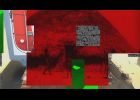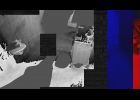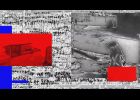Medienphilosophie als „Kommunikologie” – Vilém Flussers (1920-1991) Phänomenologie des Medialen
Despite his ambivalence towards the concept of “media”, Vilém Flusser is considered one of the foundational figures of media philosophy. His complex and associative thinking is highly sceptical with regard to traditional science-orientated media concepts. Flusser’s unique approach to media theory is fundamentally a phenomenology of the media. To capture these tensions the essay pursues a work-inherent interpretation. The essay delves into Flusser’s “Communicology” focusing on his ideas about texts, codes, symbols, and the interplay between media and human thought. One main thesis of the paper is that Flusser emphasizes in his work the need for a nuanced understanding of media philosophy, considering diverse methodological approaches and the evolving nature of media in contemporary society.
L’inter-code
In L’inter-code, a pseudo-random algorithm controls the appearance of zones of images and zones of text in mutual exclusion over the screen. The images include animations based on 3D models of objects exhibited in the Musée des Arts et Métiers in Paris: astronomical instruments which measure the infinitely big, a cyclotron which probes the subatomic world and above all, photo cameras adapted to the measure of space (photogrammetry). The images also include footages taken by the German ethnologist Theodor Koch-Grünberg in 1911 while living with the Taulipang tribe in Brazilian Guyana. The texts where extracted from the work of the philosopher Vilém Flusser, Towards a Philosophy of photography, which inspired this work. Strengthened by the soundtrack, this animation opposes Images and Texts in line with the ideas of Vilém Flusser: texts and images confront one another in the representation of the real world. This dialectical relationship, whose synthesis is yet to be discovered, is matched in the video by another opposition: tribal men living in equilibrium with nature, contrasting with the divergences of technical progress. By representing the biased relationship mankind maintains with the real when it is coded by texts and by images, L’inter-code seeks to question photographic image, not as the neutral product of a technique but as a complex construction that embeds a risk: the danger of increasing the distance between mankind and the world he inhabits. L’inter-code questions the possibilities and limits of science and its materialization in technology.
Verso una teoria dei gesti
In his work “Gesten. Versuch einer Phänomenologie,” Flusser investigates the concept of gestures. Starting from a first definition of gestures, which explores the “causality” of movements, Flusser then discusses the meaning of the concept “gesture” in the broader context of culture as a symbolic expression. In this essay, we discuss Flusser’s view on gestures by studying them with respect to their function and meaning in communicative processes, both obvious and hidden. From a semiotic point of view, we analyse Flusser’s thoughts on the function and the properties of gestures and provide a definition of “gesture”, which reflects its cultural, symbolic, and significant aspects. Particular emphasis is given to the role of gestures in communicative processes and their imbedding in the cultural environment.
McLuhan, Flusser, and the Mediatic Approach to Mind
The following text aims at reconstructing and comparing two paramount theories of the mind as historical product of the increasing predominance of media. Marshall McLuhan and Vilém Flusser both develop a theory of media, setting out, however, from very different points of departure. McLuhan tends to stress media in general, whereas Flusser insists on the importance of the predominant codes of communication. In spite of this, their theories show striking similarities. The deeper coincidence between McLuhan and Flusser lies in conceiving of existence and consciousness as formed or determined by the media. Another salient similarity can be detected in the definition of three great ages of human history, brought about by significant transformations in communication.





